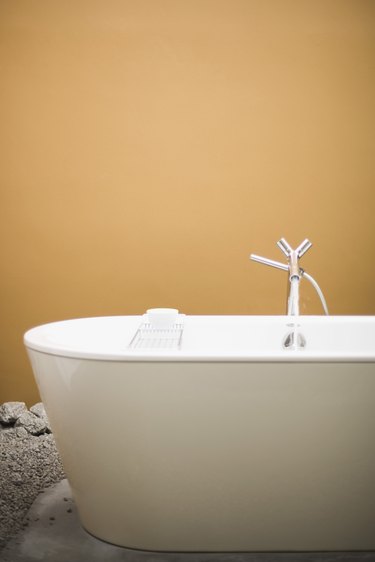
Clogs in your bathtub's drainpipe are fairly common. Typically the drain does not immediately clog, but rather it clogs slowly over time, the draining water receding slower and slower. This is typically caused by the buildup of hair, soap scum and/or hard water. Since the drainpipes are connected, the clog can cause the sink to back up when in use and vice versa. There are a handful of ways you can tackle the problem.
Plunge the Tub
Video of the Day
Place a household plunger over the tub's drain. Fill the tub with enough water to cover the base of the plunger, then pump up and down on the plunger's handle roughly a dozen times. Lift the plunger and check whether the water has begun to drain. Repeat the process until the clog is forced through and the water drains properly.
Video of the Day
Snake the Tub
Remove the overflow plate from the tub and feed roughly 30 inches of steel cable from a drain auger into the tub's overflow tube. Turn the hand crank until the clog is met. It is initially difficult to crank the cable through due to the immediate P-trap, but push past this. Once the clog is met, crank and recoil the auger multiple times in an attempt to push or latch onto the obstruction. Recoil the auger, turn on the faucet and allow several gallons of warm water to pass through the drain and flush out any remaining obstructions.
Use a Homemade Declogging Solution
Pour a cup of baking soda down the tub drain. Follow this with a cup of household vinegar and immediately cover the tub drain with the stopper. Wait 15 to 30 minutes as the solution goes to work on the source of the clog. During this time, boil a gallon of water on the stove top. Pour the boiling water down the drain to flush the solution through the drainpipe and clear the clog. Turn on the tub faucet to test the water flow. Repeat the process if the water still drains slowly.
Call a Plumber
If you've attempted to relieve the drain clog yourself a number of ways and gotten nowhere, it's time to call in a professional. Calling in a professional plumber is a smart idea to avoid potential damage to your drainpipes. The source of the clog may be something more serious than soap and hair buildup, and DIY attempts at fixing it may make matters worse. It is also smart to call in a plumber should the clog become an emergency situation, with the tub or sink overflowing onto the floor and causing potential leaks.